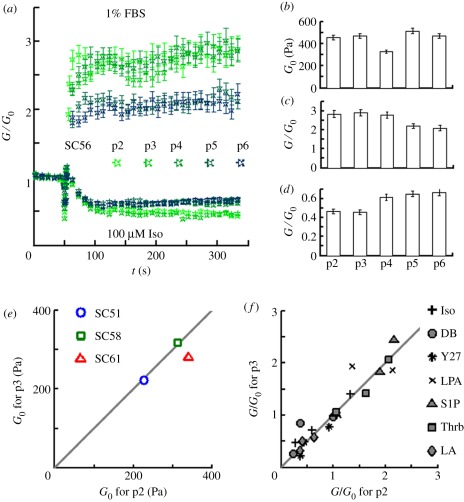Figure 2.
SC cells exhibit stable mechanical phenotype up to passage 3. (a–d) Effect of passaging on the mechanical phenotype of SC56 cells. (a) From passage 2 to 6 (p2 , … , p6), SC cells stiffen in response to FBS (upper traces) and soften in response to isoproterenol (lower traces). G/G0: current cell stiffness (G) normalized by the baseline stiffness (G0). (b–d) The effect of in vitro passaging on baseline stiffness (G0; (b)), contractile response to FBS (G/G0 at 300 s; (c)), and relaxing response to isoproterenol (G/G0 at 300 s; (d)). Passaged once per week, confluently plated SC56 cells were grown in growth media for a week, serum starved for 4–6 h (instead of the overnight starvation, which was used for all other tests), incubated with poly-l-lysine (PLL)-coated beads and challenged with 1% FBS or 100 µM isoproterenol. In (a,c,d), each data point is median value of over 250 beads; in (b), each data point is median value of over 500 beads; the error bars are standard errors. (e,f) For three other donors, we tested their SC cells both at passages 2 and 3, and found that untreated cell stiffness (e) and all drug responses (f) were nearly identical. In (f), G/G0 was evaluated differently for different drugs: G/G0 for latrunculin A (LA), LPA and S1P was evaluated at 300 s at a single dose (cf. figure 3), and G/G0 for isoproterenol (Iso), DBcAMP (DB) and Y-27632 (Y27) was obtained after long-term treatment at doses of 10 µM, 5 mM and 100 µM, respectively (cf. figure 4).

